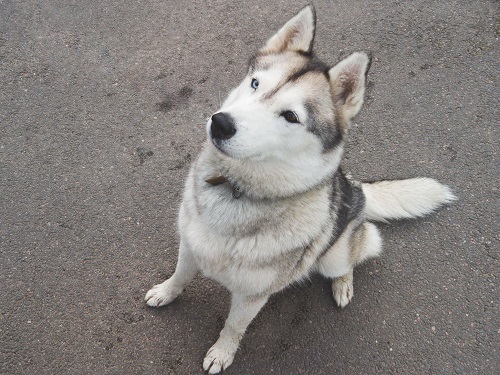There is no difference between species or barriers when it comes to communication. Our canine companions have developed a complex code of communication, and one of the most exciting aspects of this code is the positioning of their ears. Whether you own a Husky or are impressed by these beautiful creatures, understanding why Huskies put their ears back can provide valuable knowledge about their emotions and intentions.
The Anatomy of Expression
Husky Ear Anatomy
We must first examine their anatomy to the mystery behind Huskies putting their ears back. Wuskies possess highly expressive ears equipped with a wide range of movements thanks to their well-developed muscle structure. These movements allow them to convey a spectrum of emotions without barking.
The Visual Language of Ears
Much like a raised eyebrow or a friendly wave, a Husky’s ears speak volumes. A backward ear tilt typically indicates a shift in emotional state, signaling an attempt to communicate with both their human companions and fellow canines.
Emotional Cues and Context
Submission and Fear
In dog communication, ears pulled back can often signify surrender or mild fear. When a Husky finds itself in the company of a more dominant individual, this gesture is an unspoken way of acknowledging their status. Similarly, in unfamiliar or potentially threatening situations, Huskies may tuck their ears back to appear non-threatening while still being attentive.
Curiosity and Alertness
In addition to the submissive meaning, Huskies may pull their ears back when curious or curious. This intriguing paradox highlights the complexity of canine communication, reminding us that their behaviors cannot be simplified into a single explanation.
Signs of Aggression
While Huskies are known for their friendly and sociable nature, ears-back behavior may be linked to aggression. This quiet ear movement could signify a potential escalation to aggressive behavior in high-stress situations where a Husky feels trapped or threatened.
Husky Psychology: Behind the EarsPack Dynamics and Ear Position
Understanding Husky behavior requires a glimpse into their historical roots. Huskies, descendants of pack animals, carry certain behaviors from their wild ancestors. Ears-back communication could be a way to maintain harmony within the pack, preventing conflicts and promoting cooperation.
Sensory Sensitivity
Huskies are known for their acute senses, a; theirs play a vital role in this sensory perception. The ability to adjust ear position allows Huskies to regulate the amount of auditory input they receive, especially in noisy or overwhelming environments.
Interpreting Ear Movements
Ear Movement vs. Tail Wagging
Just as a wagging tail doesn’t always equate to happiness, reading ear movements requires a comprehensive understanding. While ears pulled back can indicate submission or uncertainty, the overall body language, tail position, and other cues must be considered for a complete interpretation.
Reading Other Body Language
Huskies are masters of non-verbal communication. When deciphering the meaning behind ears-back behavior, it’s crucial to analyze the complete body language ensemble. Factors such as posture, eye contact, and vocalizations provide valuable context to decode the message.

Training and Bonding
Positive Reinforcement
For Husky owners, reinforcing positive behaviors through training is paramount. When it comes to ears-back expressions, rewarding your Husky for appropriate responses can help them associate certain situations with positive outcomes, gradually shaping their behavior.
Building Trust and Understanding
A strong human-canine bond is built on mutual trust and understanding. By familiarizing yourself with your Husky’s unique ear language, you can establish a deeper connection and enhance your ability to meet their emotional needs.
Responding to Ears-Back Behavior
Creating a Comforting Environment
If your Husky consistently displays ears-back behavior, creating a safe and reassuring environment is essential. Identifying triggers that induce this response and gradually calming your dog through positive experiences can alleviate their anxiety.
Professional Intervention
In cases where signs of distress or aggression accompany ears-back behavior, seeking professional guidance from a veterinarian or animal behaviorist is crucial. These experts can provide tailored strategies to address your Husky’s specific needs.
Myths and Misconceptions
Misinterpreting the Message
The world of canine communication is complex, and misconceptions abound. Mistaking submissive ears for fear or aggression can lead to misunderstandings and misjudgments. It’s essential to approach your Husky’s behavior with an open mind and a willingness to learn.
Ears Back vs. Ears Flat
Distinguishing between ears-back and ears-flat positions is vital to accurate interpretation. While ears-back signals emotional conflict or curiosity, flattened ears typically indicate heightened alertness or a defensive stance. Learning to differentiate these nuances can enhance your ability to decode your Husky’s emotions.
Conclusion
The subtle language of Husky ears unveils a world of emotions, intentions, and connections that often go unnoticed. By recognizing the intricate interplay between their ear movements and overall body language, you can deepen your bond with your furry friend and create a harmonious environment where communication flows both ways.
FAQs (Frequently Asked Questions)
Huskies employ a rich repertoire of body language to display, and while ear movements play a significant role, they are just one piece of the puzzle.
Frequent ears-back behavior may indicate discomfort or anxiety. Observing your Husky’s overall behavior and consulting a professional if needed is advisable.
While you can’t alter the natural range of ear movements, positive reinforcement can influence when and how your Husky positions its ears.
All dog breeds have unique ways of expressing themselves, but Huskies are particularly expressive due to their intricate ear musculature.
While ears-back can indicate recommendation, it can also convey curiosity, alertness, or aggression. Context and accompanying cues are essential for accurate interpretation.
